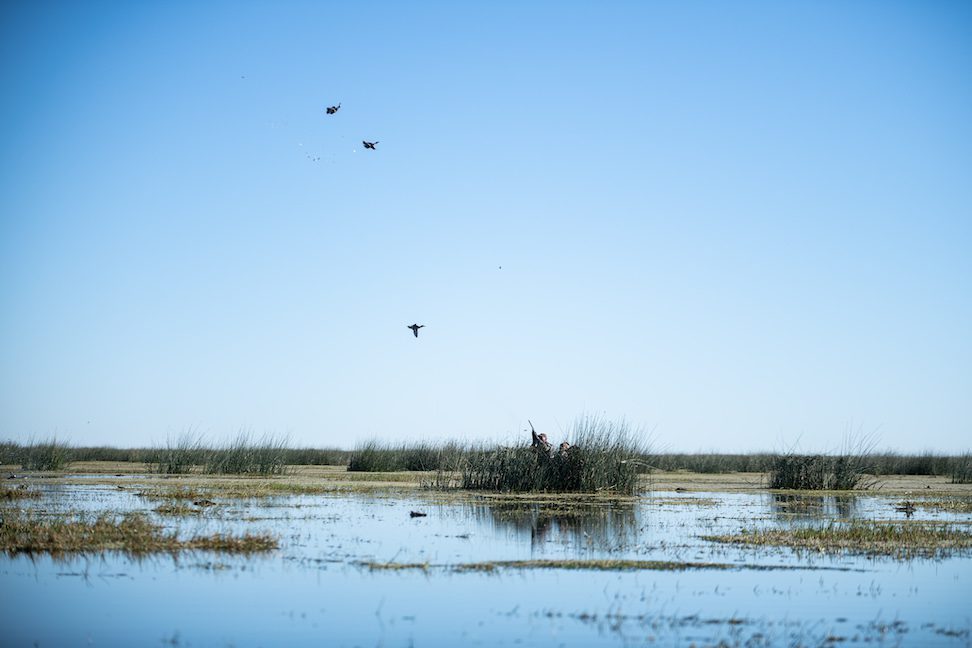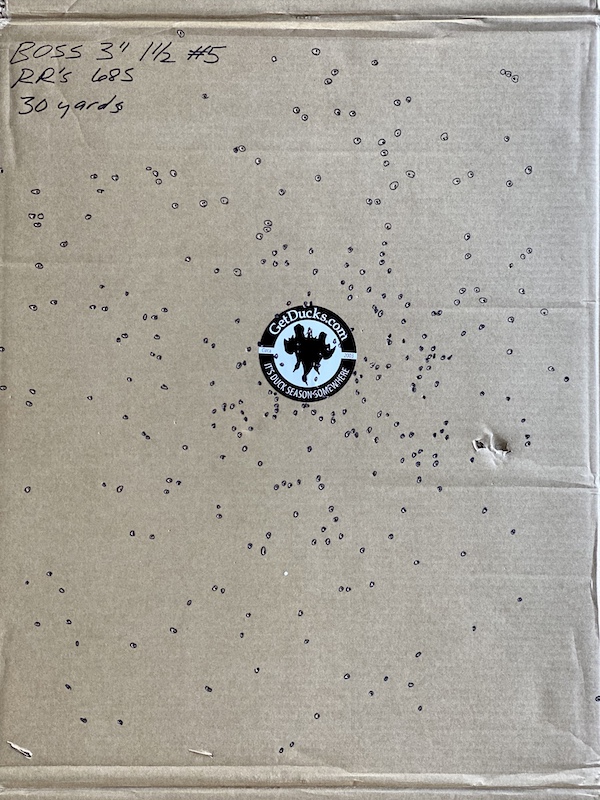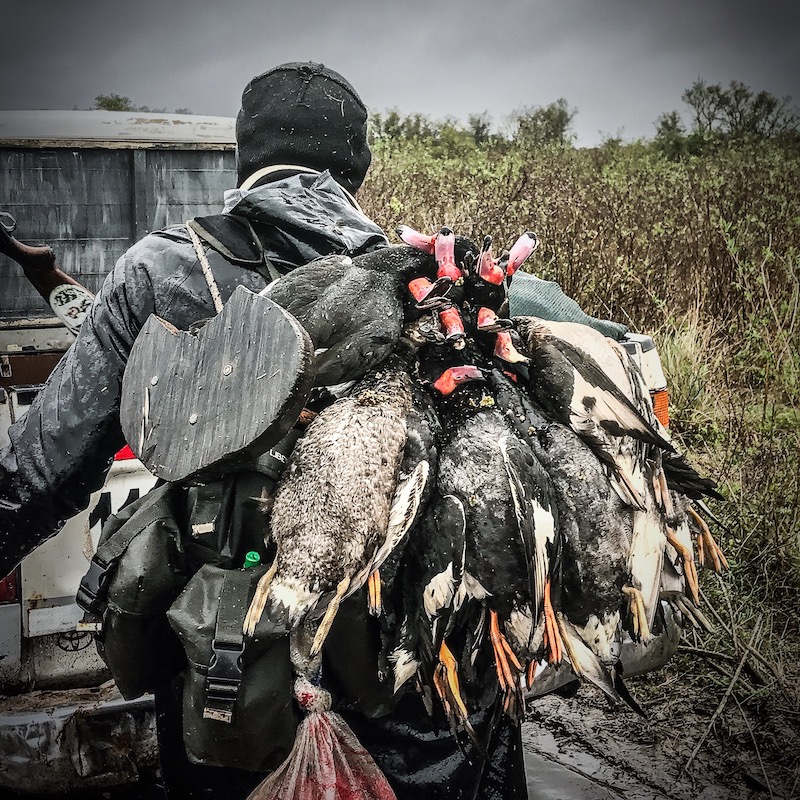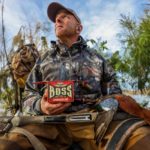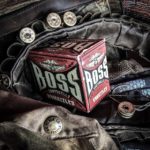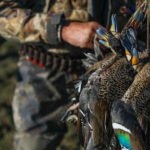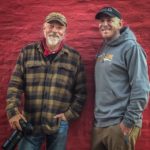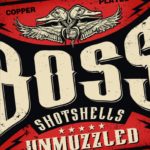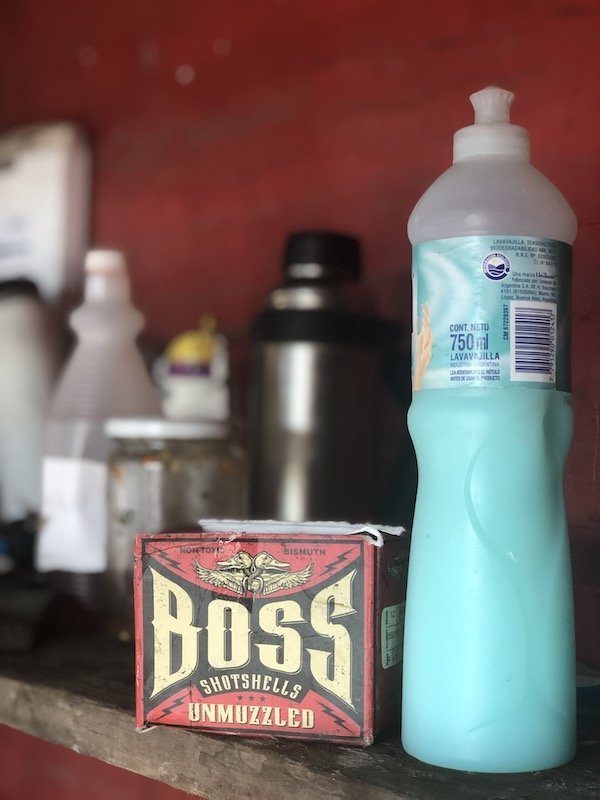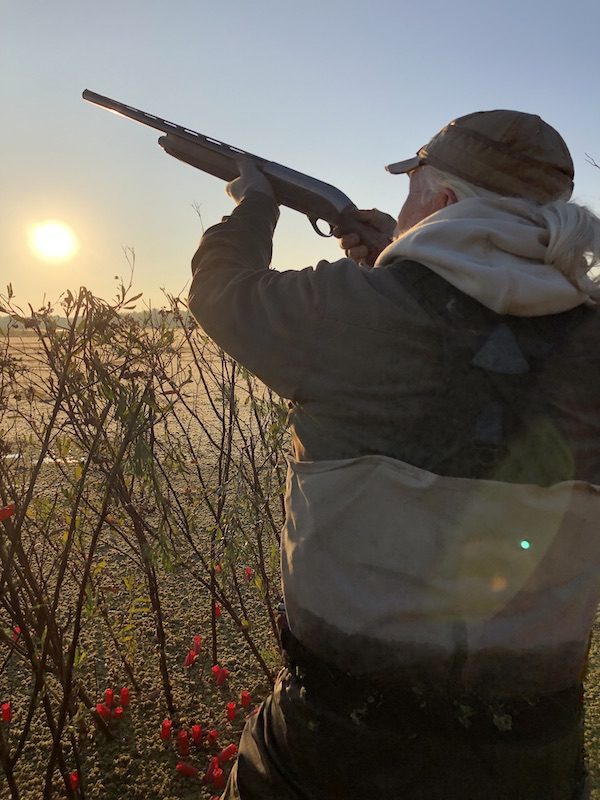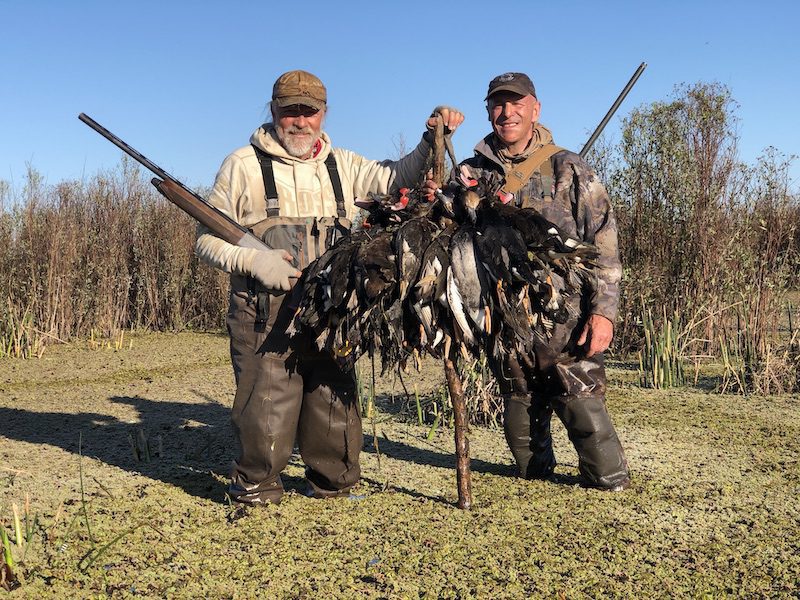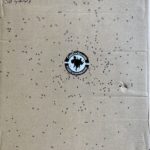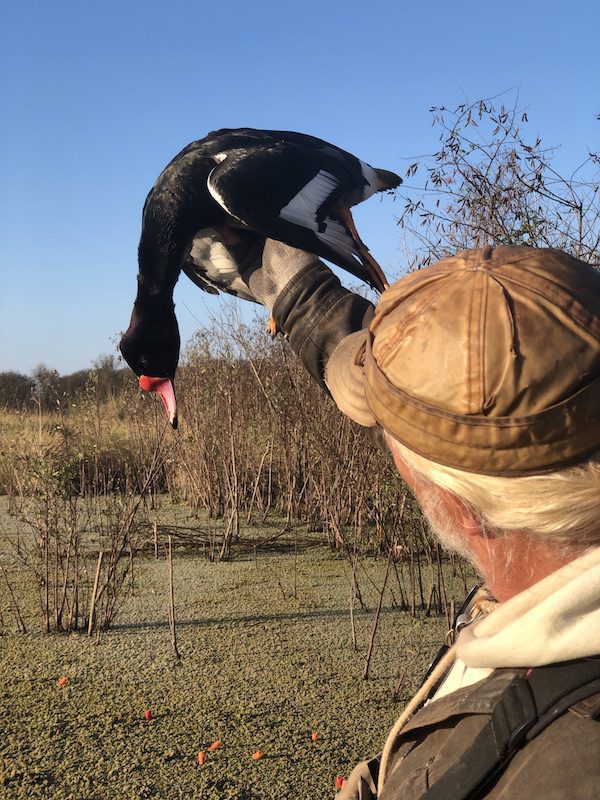Lee Kjos is STOKED about the new website launch and this season’s extensive, new BOSS Shotshells product line! Everyone is – and it’s downright contagious! Like a red, white and blue cyclone sweeping through a deserted mining town, he and Ramsey Russell plow full-steam-ahead through a range of duck hunting topics. Wondering whether the Canadian border will be open to hunters, the two plan a specklebelly hunt together just in case.
Related Links:
The Boys of Rio Salado: The Good Old Days of Waterfowling Still Exist
Lee Kjos is Absolutely STOKED by New BOSS Shotshell Developments and Customer Excitement. BOSS Shotshells’s Copper-Plated Bismuth is a Cultural Movement That’s Sweeping Through America Duck Hunting Like a Tsunami.
I know when they pull the trigger—especially the older guys that grew up, like myself, before the steel shot mandates—they’re going to find religion again in BOSS Shotshells. Those old guns, those old safe queens, those old pre-steel full choke barrels—Wow. We get to take them out again.
Ramsey Russell: Thank y’all for coming back and listening to another episode of Duck Season Somewhere. Today, I’ve got my good buddy Lee Kjos on the other line. Lee, how are you today, man?
Lee Kjos: I’m doing good. How are you?
Ramsey Russell: I’ll tell you, the world has changed. The world has changed since I talked to you last.
Lee Kjos: Man, the last time you and I talked, this COVID thing was just getting started. You and I were talking about John Prine dying.
Ramsey Russell: Yeah. He did.
Lee Kjos: Oh my god, man, he did. But, holy man, what in the fuck is going on now?
Ramsey Russell: Man, I don’t know. With four months between now and the election, I’m just hanging on. I’m like, “What in the world are they going to throw at us next?” I’m just hanging on.
Lee Kjos: I’m curious to see, this year, if voter turnout is considerably higher than normal. I would think people will go out, regardless of what side they’re on. I got to believe that there’s going to be a pile of voting. Or do you think people still think that their vote doesn’t matter?
Ramsey Russell: Lee, I have been criticized on this new, little-bitty podcast, right here, for talking politics, but I don’t know how we can be a hunter and a firearm owner, and see what we’ve seen in the last three or four months, and not have a political sense about us. I was very discouraged. The most discouraging thing I have seen or heard in the last few weeks was that, in past elections, fewer than half of hunters voted. How can you be a hunter and a firearm owner in the United States of America, with what you’re seeing on television, and not take fifteen minutes out of your day to go pull a lever?
Lee Kjos: Well, I have an opinion on that, coming from northern Minnesota. Remote northern Minnesota, where it’s a white demographic. Major sportsmen, hunt-fish guys. A lot of them live up there, and live relatively quiet lives, because that’s the way they want it. They’re kind of checked out. Right? What I’m saying is, I hope that people don’t stay checked out. That’s my message. Don’t stay checked out. You got to vote.
Ramsey Russell: You’ve got to vote. Go pull the lever. You’ll feel American. It’s good for the country. It’s good for the direction of the country that you, as a hunter and firearm owner, want this thing to go in. Go vote.
Lee Kjos: How many people fought and died so that you and I have the right to vote? I’m telling you, man. You got to vote.
Ramsey Russell: Vote. I hope everybody listening will go vote, and I will talk to everybody that you know and insist that they vote. There’s my political stunt for the day. But Lee, we’ve got to vote, man. We can’t let this thing continue. If I haven’t learned but one thing in nearly twenty years of world travel, it’s how blessed we are here in America. We enjoy a sense of freedom that nobody else on earth has. Nobody.
Lee Kjos: No. It’s not even close, Ramsey. You know how much I travel, too. I love going to see other cultures and other lands and, quite honestly, I get along with people all over the world. I have a hard time with the hate. I don’t even understand it.
Ramsey Russell: I don’t, either. Jake Latendresse and I were talking the other day, and my list of friendships looks like a Crayola box of crayons. I’ve got friends of all colors, all shapes and sizes and religions and languages. I respect it. That’s fine. I do me, and they do them. We’re duck hunters, in that moment that we’re in a blind, doing what we’re doing. From the cook to the head guide to everybody in between. You and I have shared time at lodges around the world, so you know what I mean. We’re all just duck hunters. When I come home, I do not remember any time in the past seventeen years—no matter where I was traveling, how wonderful and idyllic and special and adventurous the whole experience was—I’ve hardly ever set foot in that airport that I didn’t want to bend down and kiss the ground. Because I’m home in America, man. The hunting, the firearms, the people, the freedom to go out and do things, to own a business, to build, to chase your dreams, to participate. It’s distinctly American.
Lee Kjos: Oh, boy. Right? Don’t take it for granted. Go and vote.
Ramsey Russell: Yeah. I think we have to. I’m really not a political person, but I have to be. I have to vote. I have to participate, because I do own firearms. I do want to pass on this tradition to my children. I do want to hunt. I do want to know that the wildlife out here, these resources, are going to be taken care of. I do own a business. I do have family members that will grow up. I want my neighbors to prosper. That’s America. I’m not going to turn this whole episode into politics, Lee. We got too much to talk about.
Lee Kjos: Yeah, let’s talk about ducks.
Buzz going on around BOSS Shotshells
BOSS Shotshells Headquarters is on fire, right now. BOSS Shotshells is a direct-to-consumer model. Talking to the consumers, we have to do that. But the website is where we want them to live. It’s for them.
Ramsey Russell: Let’s talk about ducks. Let’s start off talking about BOSS Shotshells, because y’all have got some stuff going on. There’s some buzz going on around BOSS Shotshells.
Lee Kjos: Yeah. BOSS Shotshells Headquarters is on fire, right now. Well, we all have been working really, really hard on this new BOSS Shotshells website, and we’re super stoked about it. It’s beautiful. It’s user-friendly. This thing’s made for the consumer. Obviously, we’re a direct-to-consumer model. Talking to the consumers, we have to do that. But the website is where we want them to live. It’s for them.
Ramsey Russell: The stoke is off the charts. I can’t wait to see what’s coming on. What’s so important about this new web page?
Lee Kjos: Well, come October 6th, 2020, we’ll be officially two years old. That’s pretty unbelievable, what we’ve done in a year and a half or so. But along with that comes—I guess you’d call them growing pains. Most people say ours are really good growing pains. Well, I agree with that, to a point. But if your listeners went to BOSS Shotshells last year, they saw a horribly functioning website that was always out of stock. Part of that—like you and I were talking a little bit about earlier, about it being a good problem—is true. It is, because the demand is there. But when you invest time, money, and resources into getting people to your brand, I want them to have a great user experience. That’s what I want. Now, we have it. In all fairness to us a year ago, we really weren’t sure how BOSS Shotshells would be received by the community. They’ve accepted us with open arms.
Ramsey Russell: The proof is in the pudding though, and y’all—you and Brandon Cerecke and the whole staff up there at BOSS Shotshells—have got to take some credit for that. Because in the thirty years since the inception of nontoxic shot in America, there’s been a lot of overhyped, gimmicky stuff come down the pipeline. There’s been just an endless supply of hyped, hyped, hyped, gimmicks that were just, at the end of the day, steel shot. Steel shot is steel shot. Steel shot has improved a lot in the last thirty years, but it’s not as effective as good old lead. I’m blessed to have shot lead. A lot of countries around the world do not have a steel mandate, and it works as good now as it did then. I was blown away to find something that performed as good as I remember lead. I’ve talked to a lot of people about your product. I take it everywhere, and, man, I hand it out like trick-or-treat candy. Because I know when they pull the trigger—especially the older guys that grew up, like myself, before the steel shot mandates—they’re going to find religion again. Those old guns, those old safe queens, those old pre-steel full choke barrels— Wow. To take them out again.
Lee Kjos: Blow the dust off them. Get them up.
Ramsey Russell: Get them out and shoot them.
Boss Shotshells “El Jefe”
Throughout the next couple of days, the whole staff— I’d pass by a duck guide, one of the staff members, and they’d say, “El Jefe. El Jefe. Mágico Americano.” BOSS Shotshells. The Magic American cartridge.
Lee Kjos: Yep. Hey, when you and I were duck hunting at Rio Salado last year, what was that comment that Checho made about the “magic cartridge from America?”
Ramsey Russell: That’s what he said. Checho and two or three of his many brothers work at Rio Salado as Argentina duck hunting guides. I was out with his very small—but older—brother, hunting one morning, and took some BOSS Shotshells out. I got tuned in, and dialed in, just shooting those square lead target loads they were shooting. Then I just reached in my pocket and strung up my BOSS Shotshells, and it was terrific, Lee. It was just smoking. He didn’t know I’d swapped ammo. He’s kind of sitting over here to my left, facing one way, and I’m facing the other so we can be apprised of incoming ducks.
I guess he didn’t see me lift my jacket and load my cartridge belt with BOSS Shotshells. I started loading up and shooting. Several times, he’d look over, and I’d make a shot on one of those high whistling ducks, or something like that. He’d just look at me. I was dialed in, so I was in the zone, but he just kept on glancing at me. Finally, he just turned around, and he shrugged like, “What the heck?” I reached in my pocket, pulled out a BOSS Shotshell, and handed it to him.
Well, he doesn’t read English. The word for boss is “jefe.” El jefe, the boss. “Oh, el jefe. ¿Americano, sí? ¿Americano?” Boy, he was making noises. Little Johnny Felt, a bit back behind me, was filming, and you could hear him talking. Just going, “Oh! Ah! Ooh!” That pattern would just clobber those ducks, man, and stone them. Their wings would just clap, and they’d fall dead into the water. Wouldn’t even flinch on the water. They were just ooh-ing and ah-ing, and I didn’t think anything about it. We got back to camp and, throughout the next couple of days, the whole staff— I’d pass by a duck guide, one of the staff members, and they’d say, “El Jefe. El Jefe. Mágico Americano.” The Magic American cartridge.
My go-to, for BOSS, is the 2-3/4″, 1-1/4 ounce #5’s. That’s what I more or less grew up shooting: 2-3/4-inch shells. Lee, I was a grown man with kids, and went and bought a gun with a 3” chamber. Nobody in my family, growing up—nobody, my dad, my uncle, my brother, my neighbors, nobody—had a 3-inch chamber. We all shot 2-3/4-inch and I shot 2-3/4-inch. Still got that little 20-gauge 1100 with a modified choke. It was all you needed. Do you know how crazy I was? My grandfather gave me his 12-gauge Remington 1100. It was kind of an upgrade from the 20-gauge. It was a 12 gauge. It was a round barrel. I took it out this fall. I’m surprised it even had a bead on the front of the barrel. I’ve never looked at it, but I noticed it. I couldn’t afford a new shotgun after high school and college, and I went and paid to have the gun Teflon coated. There’s a company, here in Mississippi, that Teflon coats firearms. It’s indestructible. Every piece, everything—Teflon coated. You can’t put a ding in it with a ball peen hammer. It’s impervious to the elements. They’ve come up with a lot of coatings for firearms since then.
As far as I knew, when I was nineteen to twenty years old, that was the only shotgun I’d ever need in my life. Then they came out with this steel shot, and we had to convert to 3-inch. Some guys still shoot 3-1/2-inch. I don’t get it. I tried them once; couldn’t stand them. But steel shot was so light that you had to increase the speed to get the downrange energy. I finally settled in on 3-inch and 1-1/4 ounce, shooting steel shot. But when this BOSS Shotshell, copper-plated, bismuth-tin alloy ammo came out— I sometimes shoot 3-inch because it’s fun, but mostly I’m a 2-3/4-inch guy. I don’t miss the recoil at all. It’s everything I need. If it’s bigger geese—they’re a little bit further later in the season—I’ll up my pellet size a little bit. Man, I’m real pleased with them. I get a lot of questions about BOSS Shotshells. Speaking with Brandon Cerecke and yourself, it sounds like y’all have got a whole array of new products coming down.
BOSS Shotshells Continues Raising the Standard
Lee Kjos: Yeah, we do. Well, the first thing is, Brandon Cerecke never settles. You know what he’s like. If they can be better, he’ll think about it, and he’ll make it better. I can’t remember where he was, but it was bugging him: when shells fail, it’s typically in really, really cold weather. What Brandon Cerecke did with this—I guess we’ll just tell the people—the shell is new and improved, over even last year’s great shell.
Ramsey Russell: How so?
Lee Kjos: He’s got this new, hot primer in there, and shotcup, and then he tweaks with the crimp. You would take for granted a crimp in a shell, how important it is. I never thought about it. I’m like, “It just holds the BBs in.” Well, that’s not true. It does that, but it does a lot more. That’s the kind of stuff that he’s into: how it’s crimped, the depth of the crimp, all of this stuff with this hot, new primer. Unequivocally, it’s the best cold weather shell made. Period. It’s just a fantastic shell. Then he made a really cool 1-1/8 ounce load. Oh my god, the patterns are absurd with that shell.
Then the low-pressure, fiber wad shell is what I’m most stoked about, for a bunch of reasons. First of all, there’s—you mentioned safe queens, a while back—a lot of really expensive, vintage guns out there that guys would love to shoot. They’re not worried about the barrels, but they’re worried about pressures and their stocks cracking. Brandon Cerecke made this low-pressure shell, and it’s got a fiber wad in it. As long as you pick up your hull, you’re going to leave the environment every bit as good as you walked into it. No single-source plastic from a shotcup out there. No toxins. All the shells are still copper-plated. Where I think that’s going to be a big difference maker is— People that hunt in the uplands, they can still shoot lead. Well, this is a fantastic alternative, a high-quality alternative with a fiber wad, and now you’ve got a chance to get lead out of the environment. I think any time we get a chance to get lead out of the environment is something we should seriously take a look at.
Ramsey Russell: Absolutely. I know that the first couple of years—last year, for example—y’all had 2-3/4“ in 12 gauge. You had 2-3/4“ and 3” in, basically, 7, 6, 5, 4, 3, 2 and a few 1’s. Those were the options. Then for 20 gauge, it was a 3” load; 7, 6, 5, 4, 3 in shot sizes. I love to go to the social media community of BOSS Shotshells. It’s vibrant. It’s thriving. It reminds me of going into the most popular bait store in a small town, back in the day. There’s so much buzz and generation around the products and the product line. In my own business, GetDucks.com, we started off with just a handful of hunts—Canada, Argentina—and, slowly but surely over the decades, the market demand began to shape us. For—I’m just making something up—capercaillie, for red-crested pochards, for Australia or New Zealand. People would come up and they started asking, and kind of steering us, to find and explore. Now, y’all have got a lot bigger product line than even last year, don’t you? Because everybody wants to shoot something.
Lee Kjos: Well, it’s full now. It’s full. Even 10 gauge, this year.
Ramsey Russell: Oh, I didn’t know that. 10 gauge BOSS Shotshells.
Lee Kjos: Well, I’ll talk about that in one of these upcoming polls, probably right before the web launch. Officially, it launches Tuesday night—this coming Tuesday, on the 16th at 10:00 PM—but I guess you’ve got to let the servers and things like that catch up to it, so it will really be open for business when people wake up on Wednesday morning, on the 17th.
Ramsey Russell: This episode will air either Wednesday or Thursday. So guys, if y’all are listening, you ought to be able to just go check out BOSS Shotshells and see what all the buzz is about. I’ve been hearing a lot of buzz. So y’all are going to have .410 gauge, 28 gauge, 20 gauge, 12 gauge, 16 gauge?
Lee Kjos: Yep, and the 16 gauge shell is purple. Old school.
Ramsey Russell: Last time I was at the BOSS Shotshell shop, Justin brought in an old humpback Sweet Sixteen that belonged to his dad. I believe it had a full choke. We walked out back and shot a pattern, and I was blown away. Lee, at 35 yards, it was like a 96% pattern. It was something overwhelming. It was unbelievable.
Lee Kjos: Those old barrels were—
Ramsey Russell: They were drilled.
Lee Kjos: They weren’t forged barrels, back then. They’re drilled barrels. They’re good barrels, those old guns. Model 12’s—you know that old 30”, 12 gauge Model 12? 30-inch full choke with that shell that you like, that 2-3/4-inch, 1-1/4 ounce #5’s. There ain’t a better duck shell, to me. That, to me, is the new gold standard of a waterfowl shell. That’s like a 2-3/4-inch, lead, Winchester Double X back in the day. That’s what that shell is like.
The BOSS Shotshells Narrative
Since BOSS Shotshells came along. It got me back to my roots of a tighter choke, good uniform pattern density, and kill the duck. Kill him.
Ramsey Russell: Yeah, that’s what it reminds me of. I took out my grandfather’s 1100 factory mod—the one I was talking about earlier—this year, and I couldn’t miss, shooting that little load. There weren’t so many ducks. I shared it with Forrest, but it got his interest. He wants to shoot ducks with that gun now. It blew him away. Really, he’d never given any thought that that would have been his great-great-granddaddy’s gun. It just blew him away to see. He’d never seen me shoot that gun. I took my old granddad out this year and shot duck, and it was just as good as I remember. That brings up a good point. I get asked this a lot. It’s a recurring theme in your social media conversations by the people coming in to ask questions about the new BOSS Shotshell phenomenon. It’s chokes, chokes, chokes. I had shot nontoxic load steel shot for so long, I really kind of forgot about the old tight chokes. You know what I’m saying? I got away from it. I shot improved cylinder, light modified, because if we’ve got a decoy spread and the farthest decoy is 30-35 yards, improved cylinder with steel shot will handle that. Man, this stuff performs like so much like lead that you really got to tighten up that choke a little bit. A lot of these kids just don’t get it. I know a lot of people that have shot super-tight choke with steel shot, but I don’t think they ever went out and patterned it. When I patterned it back in the day, shooting a super tight choke with steel shot really just blew my pattern apart. I rarely hunt without a duck dog. If I can put a pattern density out and clobber that bird, the dog’s going to get it. I want a clean kill. It’s a game of errors. Sometimes it doesn’t happen, especially when I’m shooting steel shot. Which I haven’t done in a couple of years, since BOSS Shotshells came along. It got me back to my roots of a tighter choke, good uniform pattern density, and kill the duck. Kill him.
Lee Kjos: That’s it. That is the BOSS Shotshells narrative, right there. That’s it.
Ramsey Russell: It really is.
Lee Kjos: I want to reduce crippling to the point that it becomes insignificant. Right now, statistics say between 3.4 and 3.7 million waterfowl are lost, every year, due to crippling.
Ramsey Russell: That’s too many.
Lee Kjos: That’s a staggering number.
Ramsey Russell: That’s too many, Lee.
BOSS Shotshells, Chokes and Patterns
At BOSS Shotshells, there’s a huge habitat and conservation component to our ideology, or our narrative. Huge. Let’s face it—without habitat and conservation, we don’t have anything. Nothing. You’re not going to eliminate crippling, but I bet we could cut it 75% if people would do just what we talked about.
Lee Kjos: Oh, yeah. Now, you were talking about choke. Choke is one thing, but the relationship between the barrel, the choke, the shell, and the distance that you shoot your birds at— Which, now, you have to be honest with yourself. How do you hunt? What kind of shots do you take? Once you know that, then you start to pattern. Put it on paper. Look at it. Oh, you’re going to see a difference. Again, Brandon Cerecke is a super freak when it comes to this stuff, and he was telling me, “Take that choke and turn that choke a quarter turn. It might change the pattern.” That’s how different it is. Like you said, you sawed that out of that old barrel. What was it? Did you say it was a square back?
Ramsey Russell: No, it was an old Remington 1100.
Lee Kjos: Oh, it was an 1100. Well, my dad died in ‘94, and he shot an old Winchester Model 12, 30-inch, full choke gun his whole life. I took the gun. It had something wrong with the safety. It was stuck. I took it to a gunsmith, a friend of mine, and I just told him to fix the safety on it for me because I wanted to shoot 2-3/4-inch #5’s out of it, copper-plated BOSS Shotshells. He took the gun, he looked at it, he called me, and he said, “I took the gun apart, and I looked at it. There’s a little pitting in the barrel.” I said, “What’s the pitting from?” He goes, “Well, it’s probably residue. It’s plastic residue left over from old shells, and they hold moisture, and there’s a little bit of pitting.” Here’s what he said. He goes, “I’m going to send it to Briley, and I’m going to have them overbore it like 3000s. Clean it up.” I took that gun—this is no bullshit—I got the gun. I have a patterning board here at the farm. I took 1, 2, and 3 quarter inch shells. #5, copper-plated #5. We call it Shorty. I fired one shot at fifty yards. I knew what it would do at thirty yards. I’m like, “I wonder what this thing will do at fifty yards?” I should post it someday, but it doesn’t seem like the listenership on Instagram really likes a lot of those patterns. They’re kind of boring, I think.
But it’s a great illustration, because the pattern was a 70% pattern at 50 yards. My point is: am I going to shoot at fifty yards? Do I suggest that people do? No, but that’s the gun to do it, if you’re going to do it. I typically pattern at 30-35 yards. I look at them, because that’s where I shoot ducks. I don’t take flyer shots. I don’t take crippling shots. I’m pretty patient. Well, you’ve hunted with me. I’m patient about where I like to kill them. My point to this is, there’s many factors that go into being an effective killer. Back to the original narrative that you brought up: I want them dead.
Ramsey Russell: I want them dead. We owe it to them. We owe it to the resource. We owe it to ourselves. If you think about the time and the money and the effort that goes into anybody listening’s duck hunt tomorrow morning— A crippled duck? Best case scenario of a cripple duck is the difference in your only duck or a limit. You earned that duck, and I put too much time and money and effort into duck hunting to let cripples get away. I don’t want that.
Lee Kjos: You know how I am. At BOSS Shotshells, there’s a huge habitat and conservation component to our ideology, or our narrative. Huge. Let’s face it—without habitat and conservation, we don’t have anything. Nothing. You’re not going to eliminate crippling, but I bet we could cut it 75% if people would do just what we talked about. Let’s say you get a sheep tag. You buy a sheep tag. Do you think a guy or gal just goes to the store and picks a gun or a bow or whatever off the rack, and doesn’t dial it in, and just goes out sheep hunting with it? You cripple an animal that you paid probably— I don’t know. Some of the tags are just staggering, how much they are. My point is: is a duck worth less?
See, to me they’re not. I know that sounds like I’m a weirdo, probably. Like, “Yeah, dude, I paid $50,000 for the sheep tag.” Well, the duck’s life to me is worth— Well, they’ve earned it. They’ve earned that. If you’re going to hunt them, at least do them the solid of patterning. It’s woodsmanship skills. Those things are gone. When you grew up as a kid, I bet you were—I’m not saying forced, but you had to go out and pattern. That was just part of the deal, back then. Now, it’s like a foreign thing, and we at BOSS Shotshells are trying our best to bring that back. So I hope people will.
Now personally, I believe that for just day in, day out duck hunting in the decoys, that 30 to 35 yards zone around you—and I believe I’ve shot enough ducks over the past thirty years to prove it—I believe that somewhere in that high-40 percentile is a dense enough pattern, in that 30-inch circle, to reduce that bird to possession, especially if you’ve got a duck dog. As I started playing around with BOSS Shotshells and chokes, I realized I could do better. That became the difference in birds dying at a higher rate, versus them crippling.
Ramsey Russell: Well, I was just fixing to say, I did some patterning. Not because I was made to, but because of the kind of patterning I did. and it did. Look, here’s the deal. I had one gun when I was a little boy. It was a 20-gauge 1100. In high school, my grandfather gave me that 12-gauge because he retired. I had one gun. So it really didn’t matter how it looked on paper. I had what I had. The patterning I did as a little boy was shooting stuff on the water, or shooting a tin can, and seeing the ducks blow up all around it. Stuff like that. When I really got back into patterning was when this newfangled steel shot came along.
For those of y’all who don’t remember how this happened, in 1990 you showed up to the supermarket, or wherever you bought your ammo, and there was this steel shot on the shelves, but it wasn’t mandatory. We all grabbed lead. That’s what we’d all shot. Well, in 1991, it was mandatory. Right off the bat—there were some chat rooms on the internet, a little bit of that stuff going on, it wasn’t near what it is now—but we all found out real quickly, you knew somebody, everybody knew somebody that had that old fixed choke gun that was damaged. It would bulge on the end because steel wouldn’t conform to the barrel. Lead is malleable. It’ll bend and do a little bit of stuff coming through that barrel sometimes. Steel would not, and it damaged a lot of them old guns.
Grandpa became a safe queen. Had to go get a new duck gun. That’s what we do. We duck hunt. We went and got new guns. Well, now we have to shoot this new shot that everybody says, “Well, it’s as good as lead.” That’s when we all started patterning. Here’s what else changed. I grew up hunting in tight cover, more or less. Man, all the way through college I shot in closer stuff. Timber, brush, willow. Things of that nature. Beaver ponds. Little, narrow, minor, floodplain creeks and rivers. You didn’t need a lot. So I grew up shooting 7-1/2’s and 6’s. Sometimes 5’s. But lead 7-1/2’s and 6’s was plenty.
One thing that we all learned real quick is with steel shot you had to step up in shot size, which meant fewer pellets in the patterns. You had to shoot them faster, which meant 3”—that became 3-1/2“ shells. All these rules changed. Crap, what’s it going to do when I shoot down range? Go out to a gun range and find out. So we started patterning. Now thirty years goes by, and I was at Game Fair last year visiting with Brandon Cerecke. A part of y’all’s BOSS Shotshells display, at the time, was a wall full of 30-inch by 30 inch-inch pieces of cardboard with the cartridge length, the shot size, the speed, and everything else, where you could go through and look at all the pattern boards. Brandon asked me, “Do you know about patterning?” I shrugged and said, “I don’t pattern.” He says, “Well, but you shoot lead when you go to Argentina and Mexico.” I said, “Yeah, but I don’t pattern.”
I didn’t go walk 35-40 yards downrange and put up a board. You know how I patterned, Lee? I shot ducks. It’s one thing early in the morning when you first start shooting. The birds are coming in, and it’s something else entirely different. When the sun comes up, the birds can see better. Maybe it’s cloudy, they’re a little wilder. I do know guys that are religious about a mallard duck with his feet in the water. I’m not. If I shot two or three ducks and I noticed them winging or crippling or doing something, I reached in my pocket, pulled out a different choke, and started dialing. I want that duck dead. That’s how I patterned. Ducks in the air.
Last fall, I was up there at BOSS Shotshells, and I had my gun because I was on my way to Canada. Brandon Cerecke said, “Let’s go pattern these bad boys.” It opened my eyes. Now personally, I believe that for just day in, day out duck hunting in the decoys, that 30 to 35 yards zone around you—and I believe I’ve shot enough ducks over the past thirty years to prove it—I believe that somewhere in that high-40 percentile is a dense enough pattern, in that 30-inch circle, to reduce that bird to possession, especially if you’ve got a duck dog.
As I started playing around with chokes, I realized I could do better. That became the difference in birds dying at a higher rate, versus them crippling. That became important to me. Lee, what I’m trying to tell anybody listening is that it’s not that BOSS Shotshells are just better; it’s the narrative. How BOSS Shotshells changed the way that I think and act about shooting ducks, myself, after all these years. It’s a compliment that it makes me think. Now, I still bring a choke selection because— If I were going to go to the same pit blind, or same duck hole, day in and day out— But I don’t. I think most people listening don’t hunt the same scenario time and time again. What I’ve learned is, factory mod, factory improved mod, and factory full chokes do really, really good. I let the ducks, or the day, determine which choke goes with my gun. Day in and day out, I’m probably going to start with a factory mod.
Lee Kjos: That’s what you told me during a duck hunt in Argentina, too. Then I think you said light mod?
BOSS Shotshells costs a little more, but relative to what the average guy spends—in time and money and effort—to shoot a duck or geese, it’s worth it. We don’t think nothing about spending a lot of money on a shotgun or a retriever or decoys to give us a marginal advantage, but it all comes down to the trigger pull. That’s where I stand on it. – Ramsey Russell, “El Jefe”
Ramsey Russell: Well, I believe that if a guy, for whatever reason, is going to shoot steel shot: light mod, all the way. Light mod and improved mod, that’s the only two chokes I’ve ever used shooting steel. That’s what I came to shoot for steel shot. I thought light mod was perfect. Lee, those hunts you and I did, some of those mornings—they put us in that flow of birds that they would peel off. They were chip shots, man. We were shooting fifteen yards. A lot of these birds, at fifteen, twenty yards. I can tell you this, at forty yards a light mod, shooting those BOSS Shotshells, was around 40% pattern density. Obviously it was enough, but it’s not enough now.
I really do want a higher, more uniform pattern, and I’m willing to experiment with choke. Now when I go—especially now that I’m shooting superior BOSS Shotshells day in and day out—I’ve got three chokes in my pocket. I’ve probably got a mod in my gun to start, especially if we’re expecting decoy and chip shot birds, especially with geese. Then I’m dialing up from there.
I had a similar experience duck hunting in Azerbaijan this year. We’re able to import fifty rounds of ammo to Azerbaijan. I brought BOSS Shotshells, 2-3/4-inch #5’s. We shoot a lot of Italian lead over there. I did the same exact thing. I just grabbed a handful of BOSS Shotshells and mixed it in. All things equal, once I’m dialed in and once the light is steady, it really provides a good apple to apple comparison. Those Azerbaijan duck guides are not only hunting guides; they duck hunt for a living. They’re either hunting those ducks to eat, or they’re hunting those ducks to sell, for somebody else to eat. Modern day market hunters, a lot of them are. My bird boy that day, Adil, made the same facial expressions and asked for the explanation when he noticed. I said something to him, but he reached down and picked up the red hull instead of whatever color hulls those were we were shooting. He picked up the red hull, held it up to me, and said, “Americano.” I said, “Yes.” He says, “Kaput! Americano kaput! Killed!” He had the same expression. Because it’s a superior component to what most foreign lead shots still are. The components, the powder, the primer, the uniformity, the uniform pressures. It’s better.
Mexico, Argentina, Azerbaijan, I’ve shot it. Throughout the US and Canada, I’ve shot this BOSS Shotshell, now, and it is superior. It costs a little more, but relative to what the average guy spends—in time and money and effort—to shoot a duck or geese, it’s worth it. We don’t think nothing about spending a lot of money on a shotgun or a retriever or decoys to give us a marginal advantage, but it all comes down to the trigger pull. That’s where I stand on it.
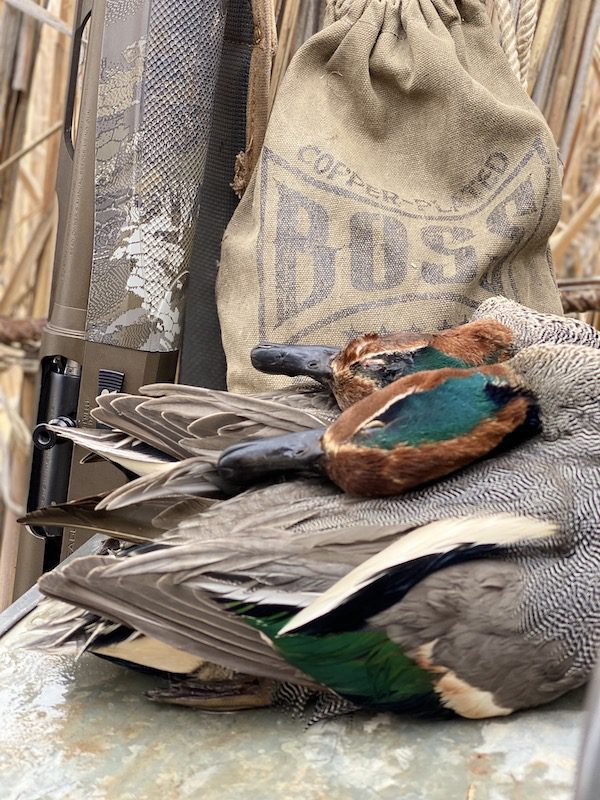
BOSS Shotshells Ammo Cost Versus Value
The only time buying an inferior steel shell is cheaper is when you pick it off the store shelf. Because you’re going to shoot more steel shells for a dead bird, for a retrieved bird, than you do with BOSS ammo. That actually makes the steel shell more expensive.
Per shell, Boss Shotshells are more expensive, but per duck, you’re way ahead because of its efficiency.
Lee Kjos: Well, that’s a good topic to talk about. You mentioned the cost. It costs a little more. I was having a conversation with one of the larger duck clubs, down South, where each guide takes out roughly eight guys a day. It’s one of the big clubs. The guides, they all shoot BOSS Shotshells. Most of the guys that come down there, that they’re guiding, shoot steel. What they’re telling me is, it’s really not more expensive. Let’s put it this way. The only time buying an inferior steel shell is cheaper is when you pick it off the store shelf. Because you’re going to shoot more steel shells for a dead bird, for a retrieved bird, than you do with BOSS. That actually makes the steel shell more expensive. I guarantee you that.
Ramsey Russell: I agree. You’ve seen that little leather belt I put on: 25 cartridges. Down in Argentina, I got two of them. You’re right because, day in and day out, I’m not the guy that puts boxes, plural, of shells in my blind bag. I’m not that guy. I come home in the mornings, or come back from the hunt, and I go to my toolbox, and I fill it back up with BOSS Shotshells. I cannot recall a single instance in the United States of America—and Canada, most mornings—when we’re shooting ducks and dark geese and light geese that I even depleted 25 rounds. I can’t remember. And I’m not a perfect shot. I wish I was.
Lee Kjos: You’re pretty damn close.
Ramsey Russell: Countless are the mornings that, really and truly, I’ll go through a fourth or a third of the belt to get a duck limit. I didn’t think about it from that angle. You’re right, man. Per shell, Boss Shotshells are more expensive, but per duck, you’re way ahead because of its efficiency.
Lee Kjos: No question. Talk to a diver hunter. We talk to guys all the time. They message me, all the time, about this. You cripple a canvasback, or cripple a bluebill, on big water and tell me how many steel shells you’re going to spend trying to kill that cripple on the water.
Ramsey Russell: You’re right. A crippled duck, or a duck on the water, is the hardest duck to kill, anyway.
Lee Kjos: And a diver is absolutely miserable, chasing them around. A bunch of our buddies right now—like the Mayor, Jeff Watt, and Ira McCauley—those guys are duck hunters. They’re duck hunters, and they’re really good at it. They’re very good shots. They love cleaning game. They love eating the game. They don’t want to shoot 3-inch 2’s. They don’t want big holes. They don’t want any of that. This is a narrative that we’ve been living with for decades now, since the lead ban, with big shot—3-inch, or, good god, 3-1/2-inch—and very poor pattern density, because you’re shooting these big pellet sizes. What we’re doing is, we’re going the other way. Smaller shot sizes. Watt shoots 6’s and 7’s in the timber. He shoots the .410. If Watt’s allowed four ducks, Watt shoots four shells. And Ira—those guys are killers, man. Ira McCauley, his favorite shell is a BOSS 20 gauge 3-inch #5. The 1-1/8 ounce load. He was shooting 6’s, and then he went to 5’s because he’s hunting mallards all the time. Late in the year, when there’s kind of a goose crossover thing—he starts shooting honkers—he shoots 4’s. 20 gauge!
Ramsey Russell: You know what impressed me? You want to talk about changing the narrative of duck hunting— What old guys like me and you say, Lee, is one thing. We’re getting long in the tooth, wouldn’t you say? Compared to our kids, for sure. My oldest son, Forrest, is 22 years old. He’s been duck hunting a long time. I started him off with 20 gauges, back in the day. Steel shot, of course. And, wow, some of the out of breath, sweaty moments I had recovering ducks, shooting 3-inch 2’s through a 20 gauge at ducks, back in the day when they were kids. This year, Forrest—he works his tail off, man, my boys work their tails off—he bought himself a Benelli 20-gauge.
Lee Kjos: M2?
Ramsey Russell: Benelli M2 Shotgun. One of the best guns ever made.
Lee Kjos: It’s a great gun.
Ramsey Russell: I agree. He bought a case of 20-gauge 3-inch #5 BOSS Shotshells, and that’s his go-to duck gun now. He retired that old Super Black Eagle. He and I did some horse swapping for it, back in the day. He had an M2 12, and I did a little horse swapping with him. He has gone—in just a couple of short years—of his own volition, to a 20 gauge. He’s gone to his own thing, and he just swears by it. I didn’t lead him down that road. He found it himself.
Lee Kjos: Mm-hmm. Did he send a gun to Rob Roberts Custom Gun Works?
Ramsey Russell: Not yet.
Lee Kjos: Man, Rob does some good work with that. With that M2, that 20 gauge, especially. I know he just did one for Dusty Brown. He made Dusty a choke. I think Dusty called it a T4. I think it’s a bored-out turkey choke from Rob. Dusty Brown, he shoots an M2 20 gauge. I believe he shoots 3-inch #4’s out of it with that choke. He sent me some video of what he was doing to specklebellies and Honkers, late last year. He’s just smacking them. You can tell just how hard they get hit. It’s great stuff. It’s so much fun to have. It’s so much fun to be a part of something like this. I kind of call it a movement. Because we are changing some things, here in the waterfowl world, and it’s really fun to be a part of it.
Ramsey Russell: I’ve said a million times—and I firmly believe this, especially in light of what appears to be the big gaslighting we’re getting on major network television, right now, over a lot of issues—I believe the future of hunting is in its past. That ethos. Those old guys. The people that raised us into this thing. They knew what they were talking about. When you start going back, when you start picking up those old guns—like that Model 12, 30-inch full choke of your dad’s, that Remington of my grandfather’s—they were good shots, but they had a lot going for them, too. They had an advantage, as compared to me and you out there shooting 3-inch steel shot. They had a huge advantage over us. The shot guns, the chokes, the lead. They had a huge advantage over us. I’m not taking anything from their shooting, as I remember it, but I’m just saying: they had a huge step up. BOSS Shotshells is a step up. Hey, I’m going to change gears on you. Tell me more, whatever you can, about this new web page.
BOSSShotshells.com Website
BOSS Shotshells new website is a great user experience. It’s full of information. All of our narratives, that we talk about, are on there. But, being a direct-to-consumer company, its main function is to help people buy. Help them to convert. Help them.
Lee Kjos: Well, first of all, it’s a great user experience. It’s full of information. All of our narratives, that we talk about, are on there. But, being a direct-to-consumer company, its main function is to help people buy. Help them to convert. Help them. You were just talking about, we’re getting a little long in the tooth. I just turned sixty. I can’t stand fiddling and fumbling my way through some e-commerce sites. It’s painful. Sometimes it just makes me leave them. What I want the people to know is, we did everything we possibly could to make this the best user experience for them. That’s kind of what we’re like at BOSS. Everything we do, we try to do the very best. We want the best one. If somebody says, “Will you guys make a 10 gauge shell?” Well, last year we couldn’t do it, but we dedicated ourselves—Brandon Cerecke did—and said, “Well, if we’re going to make it, we’ll make it for next year. It’s going to be the best one.” And it is. It’s a 3-1/2-inch #1, #2 or #3. We’ve got a bunch of buddies out in Montana that are goose hunters, and they love the 10 gauges. They even shoot side-by-sides. They’re stoked to get this shell. Me being an art guy, being a marketing guy in art—the site is even artful. It looks good.
Ramsey Russell: If you had anything to do with it, I know it’s beautiful. No doubt.
Lee Kjos: Yeah, I had a lot to do with it, but I also had a lot of help. Really, really good help.
Ramsey Russell: As someone who’s actually going through a webpage rebuild myself right now— We’ve got a lot of content on GetDucks.com. It’s 2,000, 2,500 google-indexed pages. A lot of content. It’s only eight years old. Well, eight years old in web time is the dinosaur era.
Lee Kjos: Yeah. Right?
Ramsey Russell: That’s one thing I’m thankful for about this break, this pause, this reset, was that we had time to spend some time and go back over and just make it more user-friendly.
Lee Kjos: You should put that article we did on The Boys of Rio Salado Argentina that ran in Wheels & Fields—you should put that on the website.
Ramsey Russell: I’ve already got the PDF uploaded. I’ve just got to sit down for a few minutes and get it done. Absolutely, I’m going to put that up. It’s also going to be in our upcoming catalog. We print in November. That was a really nice story, Lee. I appreciate that, man.
Lee Kjos: Yeah, well, you know what I think about Rio Salado Argentina duck hunting. It’s unbelievable place.
Ramsey Russell: Well, God willing and the creek don’t rise, we’ll be there next year.
Lee Kjos: Yeah, we’ll be there. We’ll be there.
Ramsey Russell: I have to squint to look at the dates. We are supposed to be there. Today’s Saturday. We were supposed to start hunting there Monday morning. I hate to rub that in. You and I, Fonzie, the Mayor, and everybody were supposed to be down there Monday morning.
Lee Kjos: Is it wet down there?
Ramsey Russell: It’s wet. It’s rained good. It’s in good shape. The million dollar question is, what happens when you’ve got this wild, remote place like that, that’s got so many ducks naturally, in a wet year. What happens when you don’t shoot all those ducks, this year? You’ve got to think there’s going to be a bunch. I guess their weather can be wrong like ours, but the long-term forecast is a good wet year. Add water, you got ducks. Next year ought to be special.
We still live in America. We hunt, we fish, we enjoy life in the outdoors with our friends, and that’s what we’re going to do. I think we’re going to do it in record numbers this year.
Lee Kjos: I was going to ask you this because people are starting to talk about this, they’re starting to think about it. What do you think the chances are that the US-Canada border is not going to open this fall?
Ramsey Russell: Lee, I don’t know. I’m a duck hunter. I’m an optimist, and I believe that it’s going to open. I’ve heard people say they don’t think it is. The wild card is politics. That’s the wild card. Not American politics, even. It’s going to be politics. We interviewed the executive director of Canadian Shooting Sports Association about the Canadian gun ban. Which, really, they didn’t mean for it to. They didn’t mean to disenfranchise all the Canadian hunters in an election year like they did, but they did accidentally write language that technically prohibited most 12 and all 10 gauge shotguns. Through their haste to make language and get these black guns banned, they did. We had the executive director come on. I was surprised. Of all the things he said, I was shocked to learn—I mean, Canada is a big, vibrant country—I was shocked to learn how relatively small their economy really is. It’s less than a trillion dollars. I was shocked. All the agriculture, all the beef production, all of the timber, let alone all the industry. I was just shocked. It’s a big country. I was shocked that it’s got such a small gross domestic product. The numbers are huge. When you look at what happened this spring, just in Saskatchewan; the number of fishing tourists and snow goose hunting tourists and bear tourists and early fishing tourists that couldn’t go up there, just in Saskatchewan, cost that country $150 million dollars in revenue. Just one province. So if they’re practical people, I think they’re going to feel the bite and say, “Yeah, let’s open this son of a gun.” But I don’t know. Who knows. You throw an extremely liberal political body into the mix, like Trudeau. He’s extremely liberal.
Lee Kjos: Well, he is that, so that is the wild card, for sure, there. But then the experts like Fauci and Birx, they talk about this inevitable resurgence, or spike, of COVID in the fall. They’re still ramping that up again. They’re ramping that narrative up, right now.
Ramsey Russell: Well yeah, because Trump is fixing to go hit the campaign trail, so of course they’re ramping it up.
Lee Kjos: Okay. Then if you factor in the amount of cases that we have in the US, it’s a staggering number in comparison to how very few they have in Canada. I can totally see their government going, “No, we’re going to close the border till January 1.” God, I hope not, but can I see it happening? Yeah. I never would have thought we’d be seeing what we’re seeing right now, anyway, so how much weirder can it get?
Ramsey Russell: But what you’re not seeing on the television, or in the newspapers, is the fact that in Italy—which was devastated—they can’t hardly even find any trace of it anymore. It’s gone. So we’re not hearing that part of it. Unfortunately, I would not wish what I heard—and I do know some physicians and I do know some people that contracted it—I wouldn’t wish COVID on my worst enemy. Or very few of them, anyway. But a part of me is cynical enough to think that it’s been politicized to epic proportions. Right here in the United States, a lot of blue state governors and political bodies have weaponized it against the American people and what I perceive is the American way of life. I see other countries doing likewise. I do know some Canadians—quite a few of them, in fact—and they are having a worse time with COVID over in Eastern Canada than they are out West, but the percentages of people affected are minuscule right now. Tiny. Everything I know about this topic would still fit in a snuff can. I’m really not an epidemiologist, but the way I get my mind wrapped around, I really think that, whatever this is or is not, it’s going to have to run its course. It’s not going to just magically go away because we’re all sitting inside like the cavemen dwelling back in those days. We’re just going to have to have some contact exposure to it. Mississippi has been open a long time now, relative to other states and phases, and we’re not experiencing what they’re saying is happening in some of these states. We’re just not. Now, we’re sparsely populated, 3.5 million people, but still. It’s not what they say. I don’t think it is, Lee. So I don’t know, man. It’s going to be a huge disappointment. Here I am stuck at home. I’m looking forward to Labor Day weekend and the opportunity to go to Canada as much as anybody.
Lee Kjos: Yeah, me too. I think we’re going to have a great fall. Everything that I hear in the industry, and from consumers, is that everybody is buying. They’re stoked. I think there’s going to be a lot of people out hunting this fall. A lot. I think people are changing, too. I think this COVID, and then, on the heels of COVID, this rioting and looting and all that—I think people sit back, and a bunch of people reassess what’s important. This is the longest stretch that I’ve been home on the farm in thirty years. You know how much I travel on an airplane. I’ve been home since March, and I love it. I love the simplicity of this. Is work taking a beating? Oh, yeah. A beating. You can’t travel, I can’t work, right? But I got to tell you, I love it. I just hope people don’t get depressed over everything. Hey, man, we still live in America. We hunt, we fish, we enjoy life in the outdoors with our friends, and that’s what we’re going to do. I think we’re going to do it in record numbers this year.
Ramsey Russell: I agree with you. I really do. I’m very upbeat. Usually I’m traveling this time of year, and I’ve got to say that our phones are ringing. Emails are coming in with the same optimism. People asking questions about US and Canadian hunts. People asking questions about Mexico, Argentina, and beyond, in 2021. That tells me people’s frame of mind. Of course, now I talk to duck hunters all day, and most duck hunters are optimists. I believe they are.
Lee Kjos: Yep. There’s always this season, right?
Ramsey Russell: Yeah, and I’m ready for it. I’m enjoying being at home. I’m getting some work done. I’m not going to say I’m enjoying being at home, but I’m getting some work done that needed to be done. Lee, by the time this thing airs, everybody, y’all better go to BOSSShotShells.com and take a look at this new webpage. I know, last year, a lot of clients, a lot of friends, and associates went to the web page and the whole stock was completely sold out. That’s not going to be the case this year, is it, Lee?
Lee Kjos: No, it’s stocked up right now. We have new BOSS Shotshells gear and a whole pile of inventory and shells. Right now, you can get anything you want. It might be a little early to be thinking about fall, but while that stuff’s in stock—if you’re thinking about it, I’d go there now.
Pass shooting Specklebellies with BOSS Shotshells
Ramsey Russell: Well, the only reason I have not put together my order, personally, is holding my breath and waiting to see if Canada opens. Because if Canada opens, I’ve got some situations up there. I’ll order a load that I want. If I’m just shooting in the United States, I won’t.
Lee Kjos: Are you talking about that place you shot those specks?
Ramsey Russell: Yeah. Pass shooting.
Lee Kjos: That looked like a blast. You were shooting 3-inch 4’s, weren’t you?
Ramsey Russell: I was, and this year I’ll be shooting 3-inch 2’s. Here’s the deal. There are a few guides in that little local area—and I wouldn’t dare put this on the map—that do decoy birds, but it’s a whole different mindset in that part of the world. It’s along the riverfront. You can’t lawfully hunt for miles and miles and miles within a quarter mile of that river, because it’s an inviolate sanctuary. The specklebelly migration is truly amazing, because you’ve got birds over in the Eastern Arctic, you’ve got birds in the Western Arctic, and all points in between, and they predominantly converge in this part of Canada.
Lee Kjos: Were you down by Diefenbaker?
Ramsey Russell: I couldn’t tell you that. I don’t recognize that name. I will say that. They come out of the South Saskatchewan River, I’ll tell you that much. They come out of the South Saskatchewan River and fan out to the Mississippi, Central, and Pacific Flyways. But the way we hunt— My host has been hunting a fairly substantial property that the birds aren’t landing on. It’s mule deer country. All the locals I met pass shoot. It’s part of their culture. I do not encourage reckless shooting. I don’t. I do not encourage reckless shooting. But let’s go to the BOSS mantra: know your pattern. Make ethical shots, which is knowing yourself. Make clean kills. When it was windy, when it was foggy or high clouds, and the birds were lower on the deck coming out of that River Valley, it was all 30-40 yard shots. But on some of those days, the closer birds were just a little bit further. Totally doable, if you’re not shooting reckless. I’m going to give you the one story.
Lee Kjos: Did you hear me?
Ramsey Russell: You want to go?
Lee Kjos: I want to go.
Ramsey Russell: If they open and I go, I’m going to call you.
Lee Kjos: I want to go on that one.
He said, “Son, anybody can shoot the ducks in this little, tight timber hole.” He said, “We want to land them. Not because they’re easier to shoot, but we want to own those ducks. That’s our game.
Ramsey Russell: I’d love for you to go. He’s a very dear friend of mine. I just had a very good friend and client passed who—hands down, bar none—was the best shotgunner I have ever seen. Here’s why he was good. Rarely did he miss shooting right-handed, because he was right-handed but he did equally as well off his left shoulder. When you got to a blind, he said, “Sit where you want.” He didn’t care. You weren’t going to shut him out on shooting. I asked him, “How in the world did you learn to shoot like that, Jay?” It’s not everybody that can shoot world class off their opposite shoulder. I sure as hell can’t. He said, “When I was a little boy, I had two brothers. By the time I graduated to a place in the boat where I could hunt, I got the front of the boat. I either had to learn to shoot left-handed, or I didn’t get a shot.” That man could shoot.
But now Dan has replaced that number one spot. The man can flat out shoot. All these years I’ve known him and hunted with him— I went up there last year to hunt with him where he spends a lot of time in the fall, and I realized why he was such a great shot. You’re just patient. You’ve got lots and lots of geese coming over, and you don’t try to shoot them all. You just wait, and you wait until the right shots come over, and they’re doable. I was going to say this story. I did, and I do, have friends that are absolute—if the bird’s feet aren’t splashing the water, you don’t shoot. That’s their art. That’s the way they hunt. When I first really got into duck hunting, I went to Arkansas. Two duck limit. I was hunting with a team out there. Hunted flooded timber on public land. Being a newbie at the time, and I was, I shot a couple times before they called the shots. I wasn’t scolded and talked ugly to. I do know people that would have sent me back to the boat ramp and told me to never come back. But the old man didn’t speak to me that way. He said, “Son, anybody can shoot the ducks in this little, tight timber hole.” He said, “We want to land them. Not because they’re easier to shoot, but we want to own those ducks. That’s our game. We want to work those ducks onto the water.” Then what they would do is let a child or someone else shoot. Then, during the flurry, you shot. Boom, boom, you’re done. That’s fine. Their whole art was to finish those birds on the water, which, on Arkansas public land, is easier said than done. I was hunting some Mississippi public land with a close friend of mine one time, and he is the same way. Golly, that man goes on that caller, and he’s a very good caller. I don’t care how good a caller you are, he calls, and he called the shots. We had two mallards working, and they just weren’t going to do it. The wind had quit. It was late in the season. They just decided they weren’t— But they kept coming back. He kept passing back over. We were hunting high water, low cypress trees. So when I say they were treetop high, they weren’t 27-30 yards off the deck, right? They would just glide right over our position and try to booger out. He called him back a third time, and they did it. Boom, boom. Lee, before the first duck hit the water, he had called me every name in the book. Had started on it when the second one hit the water, and he stopped and said, “Well, that’s okay, but don’t do that again.”
I know people like that, that want to get those birds in, but I don’t. I take it all in stride. I do like to pass shoot. I do like to shoot decoy ducks. I like to shoot a duck anytime I can, or a goose. I find a lot of enjoyment in the diversity of it all. Last year, I did shoot 2-3/4-inch BOSS fours and got my limit all but one day that the birds were just a little too tall to shoot with that load and the choke I had. This year, if Canada is open and I’m going back—and I am—I’m going to bring 3-inch 2’s, and they won’t be too far next year. Or 3’s.
Number one question I get asked about BOSS Shotshells, number one question— People inbox, text, email. I had a few buddies call. Shooting 2-3/4-inch shotshells? That just blows people’s minds. They just can’t. So many of this young generation has been accustomed to shooting 3-1/2-inches. The narrative is that it doesn’t matter if you’re an average shot, you’re a better shot shooting bigger shells. No, that’s not true. That’s not true at all. I got to say this. Our buddy Jeff Foiles, I stopped down and talked to him. He likes the 3-inch 5’s.
Lee Kjos: He loves the 3-inch 5s.
Ramsey Russell: He likes the big shells. Last year, I ordered a case of 3-inch 5’s. I ordered #5, 3-inch #5. 1-1/2 ounce. I’ve told this one. It may be a little crude to somebody, but it is the god-honest truth. If you rubbed the lamp and a genie popped out and granted you one wish, said, “I’ll give you one more inch”— Would you say no? I’m going to tell you what, the difference in a 2-¾” 1-1/4 ounce #5 and that 1-1/2 ounce #5 is another inch. Forrest and I shot it on mallards, and it was just feather pillow city. Then we shot some big old decoying Canada geese. It was a behemoth. It was just something else to see. I’ve run the spectrum. Since BOSS Shotshells have come out, I have shot 6’s, 5’s, 4’s, 3’s, 2’s. I run this spectrum. I see a place for all of it. There’s a place and a situation for all of them. If you’re a carpenter, you don’t just have a hammer. You’ve got other tools.
Lee Kjos: That’s what we call the game within the game. It’s fun, and it makes you better.
Ramsey Russell: It does. Folks, I appreciate y’all listening. Lee, how can people get in touch with BOSS Shotshells? One more time, just run us down. Other than Google. BOSS Shotshells got a great Instagram page. Y’all draw attention to different topics.
Lee Kjos: Yeah. I love it when people direct message through Instagram. I like that. Then, Facebook page, I guess.
Ramsey Russell: And y’all respond, Lee. A lot of these companies don’t.
Lee Kjos: I talk to everybody. I do. I answer everybody, even the hard ones. I answer them all. That’s one thing I’d like—especially on Instagram, because I run that feed—if somebody wants to ask me a question? Dude, I guarantee you I’ll answer it. I answer everybody. It might take me a while, at night, before I can get to all of them, some days, but I answer. I love hearing from people. I love it.
Ramsey Russell: Instagram, and the new web page that everybody can go to when they hear this podcast and check out. Folks, thank y’all for listening. Join us next week. We’ll be back. Thank y’all.




